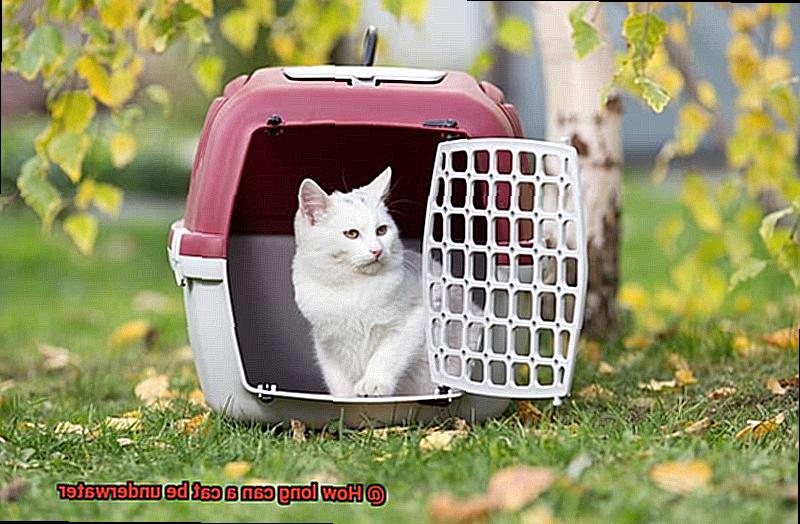Cats are known for their grace, charm, and the way they always seem to land on their feet. But did you know that these feline friends also have an impressive set of survival skills? One such skill is their ability to swim and hold their breath underwater. Have you ever wondered how long a cat can stay submerged? In this blog post, we’ll dive deep into this question and explore the aquatic abilities of our furry companions.
Although cats aren’t typically associated with water, they’re actually quite adept swimmers. With their natural balance and coordination, these creatures can navigate through the water with ease. Plus, their fastidious grooming habits come in handy when it comes to keeping their fur waterproof. All of these traits make them strong swimmers who can move through the water without getting too bogged down.
So how long can a cat hold its breath underwater? According to animal experts, these nimble creatures can go up to six minutes without taking a breath. This impressive feat is just one of the many ways that cats protect themselves in the wild. Picture a cat chasing after its prey; if danger lurks nearby, a quick leap into the water might be necessary for escape.

In conclusion, while we may not often see cats swimming or holding their breath underwater, it’s clear that they possess some remarkable talents. Their adaptability and versatility are just two more reasons why we love our feline friends so much. So next time you’re watching your kitty playfully batting at a toy or lounging in the sun, take a moment to appreciate all of the incredible things that make them such amazing creatures.
Do Cats Like Water?

While it’s true that many domestic cats may shy away from getting wet, there are some breeds that actually love playing in or near water sources.
So, why do some cats enjoy water? It all comes down to personality and experiences. Some breeds, like the adventurous Turkish Van and Bengal, have been known to swim and even fish in bodies of water. These cats may have a natural curiosity or love for water that makes them more comfortable around it.
Other cats may not be as bold in their water play but still enjoy drinking from running water sources such as faucets or fountains. This behavior is likely due to their wild ancestors’ preference for moving streams or rivers instead of stagnant pools of water.
While it’s delightful to watch our feline friends frolic in water, we must keep their safety in mind. Cats are not natural swimmers, so it’s vital to supervise them closely if they are playing in or near water.

If a cat accidentally falls into a body of water, remain calm and act quickly. Remove them from the water immediately and check if they’re responsive. If they’re not breathing or reacting, start performing CPR while seeking veterinary assistance.
It’s crucial to ensure that any body of water a cat has access to is safe and free from potential hazards such as chemicals or drowning risks. Always prioritize your cat’s safety and well-being.
How Long Can a Cat Hold its Breath Underwater?
While cats are known for their ability to swim and may enjoy playing in water, it’s important to remember that they are not aquatic animals. As such, they lack the same adaptations as marine mammals or fish that allow them to breathe underwater.
So, how long can a cat hold its breath when submerged in water? The answer is not straightforward and depends on several factors such as age, health, and physical fitness. However, on average, a healthy adult cat can hold its breath for around 30 seconds to 1 minute.
But why can’t cats hold their breath for longer periods of time? It’s because cats have a high metabolic rate and require a constant supply of oxygen to maintain their bodily functions. When submerged in water, they quickly use up their oxygen supply, leading to a short breath-holding time.
It’s also important to note that cats are not as comfortable swimming as dogs or other animals due to their natural instinct to avoid water. When submerged in water, cats may become stressed or panicked, which can cause them to inhale water and possibly drown. Therefore, it’s crucial to supervise your cat when near bodies of water to ensure their safety.
Factors Affecting the Length of Time a Cat Can Stay Underwater
While they may be able to swim, cats are not naturally equipped to breathe underwater like aquatic animals. In fact, the length of time a cat can stay submerged is influenced by many factors.
One crucial factor is the cat’s breed. Some breeds, such as the Turkish Van, are known for their love of water and swimming skills. Conversely, breeds like the Persian are less suited for aquatic activities.

Age and health also play a significant role. Younger cats typically have more energy and endurance than older cats, which can affect their ability to swim and stay underwater for longer periods. Cats with health issues or disabilities may face physical limitations that make it challenging to swim or remain submerged.
Another critical factor to consider is the temperature of the water. As warm-blooded animals, cats can become hypothermic in cold water quickly. This can impact their swimming ability and limit the amount of time they can stay underwater.
Lastly, practice makes perfect. The amount of training and practice a cat has had with swimming can improve their ability to stay underwater. Cats that are comfortable and confident in the water are more likely to remain submerged for longer periods.
What to Do if Your Cat Falls Into a Body of Water
As a cat owner, the thought of your feline friend falling into a body of water can be terrifying. However, it is important to know what to do in this situation to ensure your cat’s safety. Here are five steps to follow if your cat falls into a body of water.
Stay Calm and Act Fast
The first step is to remain calm and act fast. It’s natural to feel panicked, but sudden movements can cause your cat to struggle further. Instead, approach the situation with caution and retrieve your cat from the water as quickly as possible.
Retrieve Your Cat
If the water is shallow enough, you may be able to wade in and grab your cat. However, if the water is deep or fast-moving, do not risk your own safety and try to find something to help pull your cat out. You can use a long stick or branch to reach your cat and pull them towards you. If there are other people around, ask for their help in retrieving your cat.
Assess Your Cat’s Condition
Once you have retrieved your cat from the water, assess their condition. Even if your cat appears unharmed, it is best to take them to a veterinarian as soon as possible for a check-up. Cats can experience secondary drowning, where water enters their lungs and causes breathing difficulties hours after the incident.
Dry Your Cat Off
After being in the water, it is essential to dry your cat off and keep them warm. Use towels or blankets to dry your cat off, and consider using a hairdryer on a low setting to help speed up the drying process. Hypothermia can set in quickly, especially if the water was cold.

Seek Professional Help
If your cat is not able to grab onto an object or swim towards you, it may be time to call for professional help. Contacting a local animal rescue organization or fire department with experience in animal rescues can be the best option in this situation. They will have the necessary equipment and training to safely rescue your cat from the water.
Safety Tips for Swimming Cats
If you’re planning on taking your cat for a swim, it’s crucial to prioritize their safety. Some cats may love the water, but others may not be as comfortable or experienced. Here are five safety tips to keep in mind to ensure that your feline friend stays safe while enjoying their time in the water.

Firstly, it’s important to start slow. If your cat has never been in the water before, introduce them to shallow water first and gradually increase the depth as they become more comfortable. Avoid forcing them to swim if they seem hesitant or uncomfortable.
Secondly, always supervise your cat while they’re in or around water. Just like with children, it’s important to keep a close eye on them at all times to ensure that they don’t get into any danger. Consider investing in a lifejacket for your cat if you plan on taking them out on a boat or near deep water. This will help keep them afloat and make it easier for you to rescue them if needed.
Thirdly, make sure to keep your cat hydrated by providing them with plenty of fresh water before and after their swim. This will help prevent dehydration, which can lead to health problems.
Fourthly, be aware of signs of distress in your cat while they’re swimming. These may include excessive meowing, struggling to stay afloat, or extreme fatigue. If you notice any of these signs, take your cat out of the water immediately and seek veterinary attention if necessary.
Lastly, rinse your cat off with fresh water after swimming to remove any chlorine or other chemicals found in pools that can be harmful if left on their fur.
What Happens When a Cat Inhales Water?
Cats are natural explorers who love to investigate their surroundings, even if it means getting close to water sources. Unfortunately, this curiosity can lead to a dangerous situation called water aspiration. When a cat inhales water instead of swallowing it, serious health complications can occur that could be life-threatening.
If you suspect your cat has inhaled water, it’s essential to recognize the symptoms early on. These symptoms include difficulty breathing, coughing, wheezing, lethargy, and loss of appetite. If you notice any of these signs, seek veterinary care immediately.
When water enters a cat’s lungs, it can cause inflammation and lead to pneumonia or acute respiratory distress syndrome (ARDS). These conditions can be fatal if not treated promptly. In severe cases, your cat may require oxygen therapy or hospitalization. Your veterinarian may also prescribe medications such as antibiotics or anti-inflammatory drugs to treat any underlying infections or inflammation.
Prevention is the key to avoiding water aspiration in cats. Always supervise your cat when near water sources such as pools, bathtubs, or even outdoor bodies of water. If you’re unsure if your cat can swim or handle being in water, it’s best to avoid those situations altogether.
Here are some tips to help keep your cat safe around water:
- Supervision is crucial: Keep an eye on your cat at all times when near water sources.
- Avoid deep water: Keep your cat away from deep water if you’re unsure if they can handle it.
- Don’t force them into the water: Respect your cat’s feelings towards water and don’t force them into the situation if they’re hesitant.
- Use life jackets: Consider using a life jacket designed specifically for cats if you plan on taking them on a boat or near deep water.
Signs and Symptoms of Water Inhalation in Cats
Cats and water can be a tricky combination, as it can pose a severe danger when they inhale it. Knowing the signs and symptoms of water inhalation in cats is crucial for every cat owner to ensure their feline friend’s safety.
In mild cases, cats may cough, gag, or sneeze to clear the water from their respiratory system. However, more severe situations could lead to life-threatening conditions such as pneumonia or pulmonary edema. It’s essential to monitor your cat closely for any signs of distress, especially if they have been around water.
Some common symptoms of water inhalation in cats include lethargy, rapid breathing, difficulty breathing, blue or pale gums, coughing up blood, and a lack of appetite. If your cat exhibits any of these symptoms, seek immediate veterinary attention.
It’s crucial to note that certain cats are at a higher risk of water inhalation than others. Flat-faced breeds such as Persians and Himalayans, overweight cats, and those with respiratory issues should be monitored more closely when near bodies of water.
To prevent water inhalation in cats, always supervise them when they’re near water and avoid forcing them into it or exposing them to deep waters. Taking preventive measures can go a long way in keeping your cat safe and healthy.
Treatment for Water Inhalation in Cats
Water inhalation in cats is a serious condition that can be life-threatening. If you suspect your feline friend has inhaled water, it’s crucial to seek immediate veterinary attention. But what does treatment for water inhalation in cats involve? Let’s dive deeper.
First and foremost, the underlying cause of the water inhalation must be addressed. This can involve removing any remaining water from the lungs using oxygen therapy, medication, or a combination of both. Antibiotics may also be necessary to prevent or treat any secondary infections that may occur.
In severe cases, hospitalization may be required for several days of intensive treatment. During this time, your cat will be closely monitored, and treatment will be adjusted as needed to ensure a full recovery.
It’s also important to address any underlying medical conditions that may have contributed to the water inhalation. Managing conditions such as heart disease or asthma appropriately can prevent future occurrences.
But treatment doesn’t stop at the vet’s office. You can provide supportive care at home by administering medication as directed, providing a comfortable environment for rest and recovery, and monitoring your cat’s breathing and overall condition closely.
Prevention is key when it comes to water inhalation in cats. Ensure that your cat always has access to fresh drinking water, and never leave them unattended near bodies of water such as pools or bathtubs. If you do take your cat near water, supervise them closely and consider a life jacket if necessary.
cso87inf29Q” >
Conclusion
In conclusion, cats are not just adorable pets but also have remarkable survival skills that include their ability to swim and hold their breath underwater for up to six minutes. While some breeds like the Turkish Van and Bengal enjoy playing in water, it’s crucial to supervise them closely as cats can become stressed or panicked around bodies of water.
The duration a cat can remain submerged depends on various factors such as breed, age, health, physical fitness, and water temperature. However, unlike marine mammals or fish that possess adaptations for breathing underwater, cats lack these features.
If your feline friend accidentally falls into a body of water, it’s essential to stay calm and act fast. Follow the five steps outlined in this article: retrieve your cat quickly, assess their condition carefully, dry them off thoroughly, and seek professional help if necessary.
To ensure your cat’s safety while swimming, start slowly and gradually increase the depth as they become more comfortable. Always keep an eye on your pet when in or around water sources and consider using a life jacket designed specifically for cats if you plan on taking them near deep water or on a boat.
Lastly, if you suspect your cat has inhaled water while swimming or playing near water sources, seek immediate veterinary attention. Treatment involves addressing the underlying cause of the water inhalation through oxygen therapy or medication.







